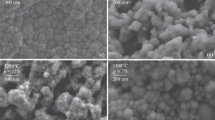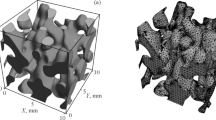Abstract
The paper focuses on experimental measurement and analytical and numerical modeling of the elastic moduli of porous Si3N4 ceramics obtained by 3D printing and pressureless sintering. The pores in such a material have complex irregular shape and porosity varies over a wide range (up to 50%), depending on the technological parameters used. For analytical modeling, we use effective field methods (Mori–Tanaka–Benveniste and Maxwell homogenization schemes) recently developed for pores of superspherical shape. For FEM simulation, we used microstructures generated by overlapping solid spheres and overlapping spherical pores. It is shown that elastic properties of ceramics are largely determined by the granular structure and the concave pore shape, which have been observed in the ceramics microstructure after sintering of the 3D-printed powder green bodies.







Similar content being viewed by others
References
Rabinskiy LN, Ripetsky AV, Sitnikov SA, Solyaev YO, Kahramanov RM (2016) Fabrication of porous silicon nitride ceramics using binder jetting technology. IOP Conf Ser Mater Sci Eng 140:012023. https://doi.org/10.1088/1757-899X/140/1/012023
Rabinsky LN, Ripetsky AV, Sitnikov SA, Solyaev Y, Kahramanov RM, Babaitsev AV (2016) In: Binder jetting of Si3N4-based composite ceramics with different porosity, materials science and technology conference, additive manufacturing of composites and complex materials symposium, 2016, Solt Lake City, 23–27 Oct
Rabinskiy LN, Ripetsky AV, Pogodin VA, Sitnikov SA, Solyaev YO (2017) Study of porous ceramic based on silicon nitride prepared using three-dimensional printing technology. Refract Ind Ceram 57:600–604. https://doi.org/10.1007/s11148-017-0030-2
Li X, Zhang L, Yin X (2012) Microstructure and mechanical properties of three porous Si3N4 ceramics fabricated by different techniques. Mater Sci Eng A 549:43–49. https://doi.org/10.1016/j.msea.2012.03.114
Li X, Zhang L, Yin X (2012) Effect of chemical vapor infiltration of Si3N4 on the mechanical and dielectric properties of porous Si3N4 ceramic fabricated by a technique combining 3-D printing and pressureless sintering. Scr Mater 67:380–383. https://doi.org/10.1016/j.scriptamat.2012.05.030
Duan W, Yin X, Cao F et al (2015) Absorption properties of twinned SiC nanowires reinforced Si3N4 composites fabricated by 3D-printing. Mater Lett 159:257–260. https://doi.org/10.1016/j.matlet.2015.06.106
Gibson I, Rosen DW, Stucker B (2013) Additive manufacturing technologies. 3D-printing, rapid prototyping, and direct digital manufacturing. Springer, Berlin, p 499
Barmin A, Bortnikova V, Ivanov A, Kornev V, Lurie SA, Solyaev YO (2016) Microstructure and mechanical properties of silicon carbide ceramics reinforced with multi-walled carbon nanotubes. IOP Conf Ser Mater Sci Eng 124:012142. https://doi.org/10.1088/1757-899X/124/1/012142
Guo N, Leu MC (2013) Additive manufacturing: technology, applications and research needs. Front Mech Eng 8:215–243. https://doi.org/10.1007/s11465-013-0248-8
Eckel Zak C, Zhou Chaoyin, Martin JH, Jacobsen AJ, Carter WB, Schaedler TA (2016) Additive manufacturing of polymer-derived ceramics. Science 351:3–7. https://doi.org/10.1126/science.aad2688
Bai Y, Wagner G, Williams CB (2015) Effect of bimodal powder mixture on powder packing density and sintered density in binder jetting of metals. In: Annual international solid freeform fabrication symposium, p 62
Shrestha S, Manogharan G (2017) Optimization of binder jetting using Taguchi method. JOM, J Miner Met Mater Soc. https://doi.org/10.1007/s11837-016-2231-4
Chen H, Zhao YF (2016) Process parameters optimization for improving surface quality and manufacturing accuracy of binder jetting additive manufacturing process. Rapid Prototyp J 22:527–538
Gonzalez JA, Mireles J, Lin Y, Wicker RB (2016) Characterization of ceramic components fabricated using binder jetting additive manufacturing technology. Ceram Int 42:10559–10564
Kachanov M, Sevostianov I (2012) Rice’ s internal variables formalism and its implications for the elastic and conductive properties of cracked materials, and for the attempts to relate strength to stiffness. J Appl Mech 79:1–10
Bruno G, Kachanov M, Green DJ (2016) Microstructure-property connections for porous ceramics: the possibilities offered by micromechanics. J Am Ceram Soc 99:3829–3852. https://doi.org/10.1111/jace.14624
Fu Z, Schlier L, Travitzky N, Greil P (2013) Three-dimensional printing of SiSiC lattice truss structures. Mater Sci Eng A. https://doi.org/10.1016/j.msea.2012.09.107
Roberts AP, Garboczi EJ (2000) Elastic properties of model porous ceramics. J Am Ceram Soc 83:3041–3048. https://doi.org/10.1111/j.1151-2916.2000.tb01680.x
Bruno G, Efremov AM, Levandovskyi AN, Clausen B (2011) Connecting the macro- and microstrain responses in technical porous ceramics: modeling and experimental validations. J Mater Sci 46:161–173. https://doi.org/10.1007/s10853-010-4899-0
Sadowski T, Samborski S (2003) Prediction of the mechanical behaviour of porous ceramics using mesomechanical modelling. Comput Mater Sci 28:512–517. https://doi.org/10.1016/j.commatsci.2003.08.008
Giraud A, Sevostianov I (2013) Micromechanical modeling of the effective elastic properties of oolitic limestone. Int J Rock Mech Min Sci 62:23–27. https://doi.org/10.1016/j.ijrmms.2013.04.001
Chen F, Sevostianov I, Giraud A, Grgic D (2015) Evaluation of the effective elastic and conductive properties of a material containing concave pores. Int J Eng Sci 97:60–68. https://doi.org/10.1016/j.ijengsci.2015.08.012
Sevostianov I, Giraud A (2012) On the compliance contribution tensor for a concave superspherical pore. Int J Fract 177:199–206. https://doi.org/10.1007/s10704-012-9754-7
Chen F, Sevostianov I, Giraud A, Grgic D (2017) Accuracy of the replacement relations for materials with non-ellipsoidal inhomogeneities. Int J Solids Struct 104–105:73–80. https://doi.org/10.1016/j.ijsolstr.2016.10.023
Mori T, Tanaka K (1973) Average stress in matrix and average elastic energy of materials with misfitting inclusions. Acta Metall 21:571–574
Benveniste Y (1987) A new approach to the application of Mori–Tanaka’s theory in composite materials. Mech Mater 6:147–157
Benveniste Y (1990) Some remarks on three micromechanical models in composite media. J Appl Mech 57:474–476
Maxwell JC (1873) A treatise on electricity and magnetism. Clarendon Press, Oxford
Open source 3DP 3D printer Plan B, http://ytec3d.com/plan-b/
Sevostianov I, Giraud A (2013) Generalization of Maxwell homogenization scheme for elastic material containing inhomogeneities of diverse shape. Int J Eng Sci 64:23–36
Sevostianov I (2014) On the shape of effective inclusion in the Maxwell homogenization scheme for anisotropic elastic composites. Mech Mater 75:45–59
Hashin Z (1983) Analysis of composite-materials—a survey. J Appl Mech 50:481–505
Stauffer D, Aharony A (1992) Introduction to percolation theory, 2nd edn. Taylor and Francis, London
Sevostianov I, Kováčik J, Simančík F (2006) Elastic and electric properties of closed-cell aluminum foams. Cross-property connection. Mater Sci Eng A 420:87–99
McLaughlin R (1977) A study of the differential scheme for composite materials. Int J Eng Sci 15:237–244
Vavakin AS, Salganik RL (1975) Effective characteristics of nonhomogeneous media with isolated inhomogeneities. Mech Solids 10(1975):65–75
Sevostianov I, Kachanov M (2007) Relations between compliances of inhomogeneities having the same shape but different elastic constants. Int J Eng Sci 45:797–806
Trofimov A, Drach B, Sevostianov I (2017) Effective elastic properties of composites with particles of polyhedral shapes. Int J Solids Struct 120:157–170
Sevostianov I, Kachanov M (2010) Local minima and gradients of stiffness and conductivity as indicators of strength reduction of brittle-elastic materials. Int J Fract 164:147–154
Acknowledgements
Financial support from Russian Federal Targeted Program “Research and Development under Priority Areas of Russian Science and Technology on 2014–2020 years,” Agreement No. 14.577.21.0171 (identifier RFMEFI57715X0171) and NASA Cooperative Agreement NNX15AL51H to New Mexico State University are gratefully acknowledged.
Author information
Authors and Affiliations
Corresponding author
Rights and permissions
About this article
Cite this article
Lurie, S.A., Solyaev, Y.O., Rabinskiy, L.N. et al. Mechanical behavior of porous Si3N4 ceramics manufactured with 3D printing technology. J Mater Sci 53, 4796–4805 (2018). https://doi.org/10.1007/s10853-017-1881-0
Received:
Accepted:
Published:
Issue Date:
DOI: https://doi.org/10.1007/s10853-017-1881-0




